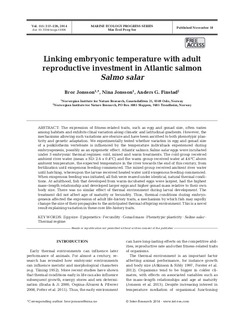Linking embryonic temperature with adultreproductive investment in Atlantic salmonSalmo salar
Peer reviewed, Journal article
Published version

Åpne
Permanent lenke
http://hdl.handle.net/11250/2561766Utgivelsesdato
2014Metadata
Vis full innførselSamlinger
- Publikasjoner fra CRIStin - NINA [2364]
- Scientific publications [1392]
Sammendrag
The expression of fitness-related traits, such as egg and gonad size, often varies
among habitats and exhibits clinal variation along climatic and latitudinal gradients. However, the
mechanisms allowing such variations are obscure and have been ascribed to both phenotypic plasticity
and genetic adaptation. We experimentally tested whether variation in egg and gonad size
of a poikilotherm vertebrate is influenced by the temperature individuals experienced during
embryogenesis, possibly as an epigenetic effect. Atlantic salmon Salmo salar eggs were incubated
under 3 embryonic thermal regimes: cold, mixed and warm treatments. The cold group received
ambient river water (mean ± SD: 2.6 ± 0.4°C) and the warm group received water at 4.6°C above
ambient temperature, the expected temperature in the river towards the end of this century, from
fertilization until exogenous feeding commenced. The mixed group received ambient river water
until hatching, whereupon the larvae received heated water until exogenous feeding commenced.
When exogenous feeding was initiated, all fish were reared under identical, natural thermal conditions.
At adulthood, fish that developed from warm-incubated eggs were largest, had the highest
mass−length relationship and developed larger eggs and higher gonad mass relative to their own
body size. There was no similar effect of thermal environment during larval development. The
treatment did not affect age of maturity or fecundity. Thus, thermal conditions during embryo -
genesis affected the expression of adult life-history traits, a mechanism by which fish may rapidly
change the size of their propagules to the anticipated thermal offspring environment. This is a novel
result explaining variation in these core life-history traits. Egg size · Epigenetics · Fecundity · Gonad mass · Phenotypic plasticity · Salmo salar ·
Thermal regime